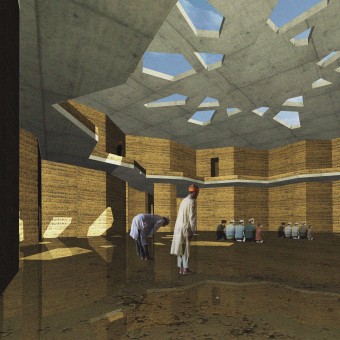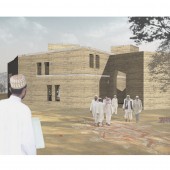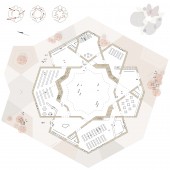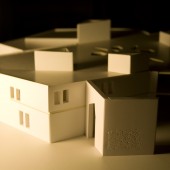
| THE AWARD |
| CATEGORIES |
| REGISTRATION |
| SUBMIT YOUR WORK |
| ENTRY INSTRUCTIONS |
| TERMS & CONDITIONS |
| PUBLICATIONS |
| DATES & FEES |
| METHODOLOGY |
| CONTACT |
| WINNERS |
| PRESS ROOM |
| GET INVOLVED |
| DESIGN PRIZE |
| DESIGN STORE |
| THE AWARD | JURY | CATEGORIES | REGISTRATION | PRESS | WINNERS | PUBLICATIONS | ENTRY INSTRUCTIONS |
Friday Mosque, Uae Religious, Educational and Social Facility by Florian Berner |
Home > Winners > Design #24337 >Interview |
 |
|
FS: What is the main principle, idea and inspiration behind your design?
FB: Our design project is part of an international open competition for a new ’Friday mosque’ in the Unites Arab Emirates. As several sites were proposed, we focused on the question ’How to anchor a building of this scale within its unknown context?’ The project is built on the following four main ideas: Identity - An open welcoming place - Ecological materials - Natural Light Identity Inspired by infinite patterns of the 12th century, craftsmanship and atmosphere it creates both an indigenous and a sensuous architectural impression. Realizing these well known elements, the building, even tough big in scale, will appear familiar and settled in its new surrounding. An open welcoming place Open to all cardinal directions, the building and its internal arrangement of spaces aim to welcome and host people. It is configured as an all day municipal institution for public, religious, educational and social facilities. The chosen radial liturgy adopts the equipoise of traditional Islamic architecture. Several passageways lead into and through the building. Informal communication and exchange of thoughts happens naturally within various architectural spaces. Differently dimensioned gather and recreation areas give privacy and comfort to small or larger groups. Circulation between these zones is possible and intended along the central main prayer hall. Natural building materials Rammed Earth is used for all vertical construction. This traditional low cost material consists of a mix of 70% gravel and 30% clay and should be available directly on site. All walls are designed in a way a mechanised rammed earth construction method can be used, so the process can be accelerated. Secondary material can be held to minimum with the assignment of climbing formworks. Being surrounded by earth a natural, balanced atmosphere is generated. All horizontal components are built in precast concrete, which is an often-used construction material in the UAE. Ceilings and Roof Slabs can be produced time efficient while the walls are erected on site. In contrast to the hand-made earth construction, the advantages of factory made precision can be used for several components of the building : Openings in various shapes; ornamental surface inlays; integrated artificial lighting; recessed connection pads Natural Light In internal spaces, generated with pure materials earth and concrete only, light is a powerful instrument to create unique atmospheres. Three characters of light are used to give different spirits to each room, according to its function Traditional windows - Rooms connected to both, the internal flow of spaces and the external world. Depending on the sill height of each window (e.g. floor level at women’s room first floor or 4m above ground in the public library), direction and external objects (tress, neighbours) views are guided. Roof lights - Traditionally used in the main prayer hall, where no horizontal light enters the room but ornamental openings at roof level connect to the sky above. Diaphanous walls - These rooms have an introverted character with no visual connection to their surrounding (e.g. tearoom).
FS: What has been your main focus in designing this work? Especially what did you want to achieve?
FB: One question was, how can we design emotion and identity without loosing the human scale? We defined the mosque through its particular shape, natural materials and various surfaces. While the walls follow a traditional pattern, section and facades refer to naturally grown earth villages.
FS: What are your future plans for this award winning design?
FB: Together with the ’Traffic design gallery’ in Dubai, UAE, we are looking for an investor/ client and site to realize the proposed mosque. We believe that the principles of this design are strong enough to be adopted to various urban contexts.
FS: How long did it take you to design this particular concept?
FB: We worked on the design over a period of 6 months. The international design competition was divided in two phases. Together with 9 more finalists we were chosen for the second phase. At this stage we specified the internal spaces and details of the construction process. In the end we came up with a geometrically simple shape. The walls, follow the traditional pattern. They are cut by a double inclined roof-surface. The result is a creation of various shapes in section and facade. From human perspective the building seems playful, as if it was naturally build step by step within years.
FS: Is your design being produced or used by another company, or do you plan to sell or lease the production rights or do you intent to produce your work yourself?
FB: The project is also published by the ’Traffic Design Gallery’ in Dubai, neverthles all rights belong to us - ’Weyell Berner Architekten’. We are currently looking for an investor or client to realize the building.
FS: What made you design this particular type of work?
FB: We are fascinated by traditional and sacral architecture all over the world, and especially of the middle east. So we were looking for a demanding project to transform these existing qualities into forward-looking and sustainable architecture.
FS: Where there any other designs and/or designers that helped the influence the design of your work?
FB: We worked on the subject of structure and light. Therefore we are inspired by the 'Kolumba' Museum in Cologne, a project of Peter Zumthor, and by sacral projects from Sigurd Leverentz. Another main topic is ornament within architecture, a traditional subject of the islamic world to distract from the noisy world around us and lead into a calm and serene space, a particular universe. Some of the entrance halls are open to the sky but enclosed by rammed earth walls. In other areas, perforated walls with ‘light holes’ generate a bright, breezy and comfortable atmosphere and create a light and shadow pattern on each wall and floor. We were also inspired by the work of Gramazio Kohler called ‚Digital Materiality’ which means that ‚programming and construction are interwoven’.
FS: Who is the target customer for his design?
FB: Possible investors would be citys, communes or associations that would like to build a new but sustainable sacral space.
FS: What sets this design apart from other similar or resembling concepts?
FB: In a surrounding where globalisation and foreign star architects influence the appearance of a whole region, it was our aim to develop an architectural expression out of traditional elements. For us, it was crucial to analyse both, theoretical and practical customs. It was our aim to propose a building which is traditional but new at the same time. Local customs had a strong influence on form, construction, function and materiality.
FS: Which design tools did you use when you were working on this project?
FB: At first we analized existing references and historical texts only. Afterwards, during the design process, we prefer to work with hand drawings and physical cardboard models. We belief these are the best tools to work out proportion and concept for architectural spaces. Then afterwards we develop and precise the concept in CAD and 3D computer animation.
FS: Who did you collaborate with for this design? Did you work with people with technical / specialized skills?
FB: Although rammed earth structures belong to the oldest way of building, only a few experts do research with this natural material. We collaborated with Martin Rauch, from Schliens Austria (www.lehmtonerde.at), one of the renowned experts worldwide. With him we developed not only the structure and the construction process, but also surfaces, haptics, formal expression, and more.
FS: What is the role of technology in this particular design?
FB: High tec and low tec – it was our aim to create an archaic building made of natural materials. Innovative technology is used to simplify the building process and to treat the material and surfaces. IT-developments and mechanised methods allow a variety of new possibilities for on site construction. Transportable robots are used to treat the surface, generate specific openings/ windows as well as diaphanous rammed earth walls. On the other hand we use traditional cooling (chimneys) and isolation techniques, so the building adapts perfectly to local condition and has an excellent eco-balance. Thick walls ensure a well-balanced insulation and a natural regulation of the internal humidity. Mud shingles protect the roof in summer times and, inlaid in the external walls, stop erosion of the outer surface.
FS: What are some of the challenges you faced during the design/realization of your concept?
FB: As said before, one challenge was to design a building with identity without a precise context. Further the new mosque should be open to all radial directions and to people of all religious denominations. That is why we included several functions within the building. We focused on the arrangement and combination of these internal spaces. It was our aim to have a good mixture of functions where, in respect of islamic customs, informal meetings and talks are possible. Horizontal and vertical circulation is equally important as areas for privacy, recreation and contemplation. We were focused on the arrangement and combination of these internal spaces. It was our aim to have a good mixture of functions where, in respect of islamic customs, informal meetings and talks are possible. So circulation, horizontal and vertikal, is as important as areas for privacy, recreation and contemplation.
FS: How did you decide to submit your design to an international design competition?
FB: For us, its a welcome platform to exchange interests with other architects and designers. We are pleased to present our work, ideas and our office ’Weyell Berner Architekten’ Zürich.
FS: Thank you for providing us with this opportunity to interview you.
A' Design Award and Competitions grants rights to press members and bloggers to use parts of this interview. This interview is provided as it is; DesignPRWire and A' Design Award and Competitions cannot be held responsible for the answers given by participating designers.
| SOCIAL |
| + Add to Likes / Favorites | Send to My Email | Comment | View Press-Release |





